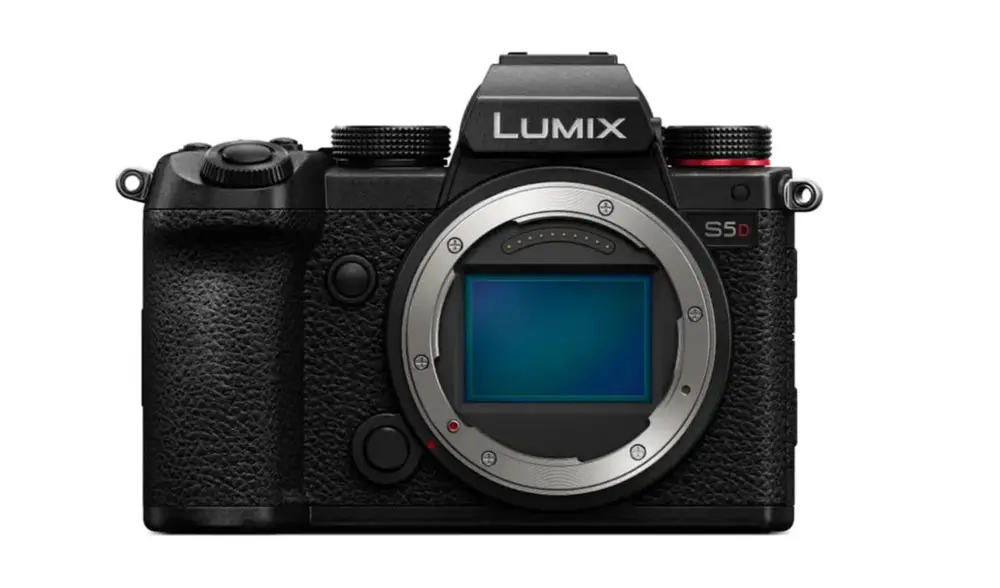Panasonic has officially announced the Lumix S5D, a slight refresh of its popular Lumix S5 mirrorless camera. Positioned as a powerful yet affordable camera for both photographers and videographers, the Lumix S5D is designed to balance performance and portability, offering impressive features for a wide range of users—from professionals to content creators.
While the improvements might seem minor at first glance, the new features and lower price point make the S5D an attractive option in the competitive world of full-frame cameras. One of the most notable upgrades in the Lumix S5D is its compatibility with DJI’s LiDAR autofocus system and the DJI RS 3 Pro Gimbal. This new pairing aims to enhance autofocus speed, a feature that could be a game-changer for photographers and videographers. The original Lumix S5, while highly regarded, was often criticized for its slow and sometimes inconsistent autofocus performance. By integrating the DJI LiDAR system, which boasts 43,200 ranging points within a 14-meter range, Panasonic is attempting to address these concerns. The system provides precise focus feedback to drive lens autofocus, offering a more reliable performance, especially in challenging lighting conditions. This partnership does not require additional calibration or accessories, making it a seamless solution for users.
Key Features and Performance
Despite this improvement, the S5D doesn’t feature Panasonic’s newer phase-detect autofocus system, which debuted in the Lumix S5 II. This means the contrast-detect autofocus, which has been slower and less advanced compared to other systems, is still in use. While the DJI LiDAR system can offer some assistance, users seeking the fastest and most intelligent autofocus may still find the S5D slightly lacking in this department compared to rivals.
The Lumix S5D retains the same 24.2-megapixel full-frame CMOS sensor found in the original S5. This sensor, combined with Dual Native ISO technology, allows the camera to capture impressive images with a wide dynamic range and excellent low-light performance. The camera offers a maximum ISO of 51200 and dual native ISOs at 640 and 4000, providing greater flexibility for both stills and video. The 14+ stops of dynamic range ensure high-quality detail in both bright and dark areas of an image, making the S5D a solid choice for professional content creators.
On the video side, the Lumix S5D continues to impress with its 4K capabilities. It can shoot 4K at 60p/50p with 4:2:0 10-bit color depth, or 4K at 30p/25p with 4:2:2 10-bit internal recording for up to 30 minutes. For those requiring longer recording times, the camera offers unlimited 4K 30p/25p 8-bit recording. Furthermore, users can connect the S5D to an Atomos external recorder for even more advanced video formats, such as 5.9K 29.97p/25p or 4.1K 59.94p/50p, and Anamorphic 3.5K 50p recording, making it a versatile option for videographers working in a range of formats.
The camera also features Panasonic’s highly praised Dual I.S. (Image Stabilization) system. The 5-axis in-body image stabilization works in tandem with compatible L-mount lenses that offer 2-axis optical stabilization, providing up to 6.5 stops of stabilization. This makes handheld shooting much easier and smoother, especially when working in low-light situations or when shooting video.
Price, Design and Usability
While the new features are exciting, perhaps the most appealing aspect of the Lumix S5D is its price point. Priced at £1,399 for a kit including the brand new Lumix S 18-40mm f/4.5-6.3 lens, or £1,799 for a kit including the Lumix S 28-200mm f/4-7.1 lens, the S5D offers excellent value for a full-frame mirrorless camera. However, the original Lumix S5 remains available and, in many regions, is being offered at a discount. In the UK, for instance, the S5 with the 20-60mm kit lens can be found for as low as £999, and the body alone is priced at £799. For those not needing the new LiDAR autofocus functionality, the original S5 might be the more cost-effective option.
It’s worth noting that the S5D does not have a body-only purchase option at launch, limiting flexibility for users who might already have compatible lenses. Additionally, while the S5D’s compatibility with DJI’s LiDAR system and gimbal is a key selling point, it appears that Panasonic is not advertising the latest DJI models, such as the DJI Focus Pro LiDAR or DJI RS 4 gimbal. This may raise questions about long-term compatibility and availability, particularly as these older DJI models become harder to find in stock.
Conclusion
In conclusion, the Panasonic Lumix S5D is a solid evolution of the original S5. It offers valuable upgrades, such as DJI LiDAR autofocus compatibility, while retaining the impressive video and image quality of its predecessor. For those seeking a capable, budget-friendly full-frame camera, the S5D is certainly worth considering—especially for users invested in video production. However, with the original Lumix S5 still widely available at lower prices, it may be worth evaluating both models carefully before making a final decision.

